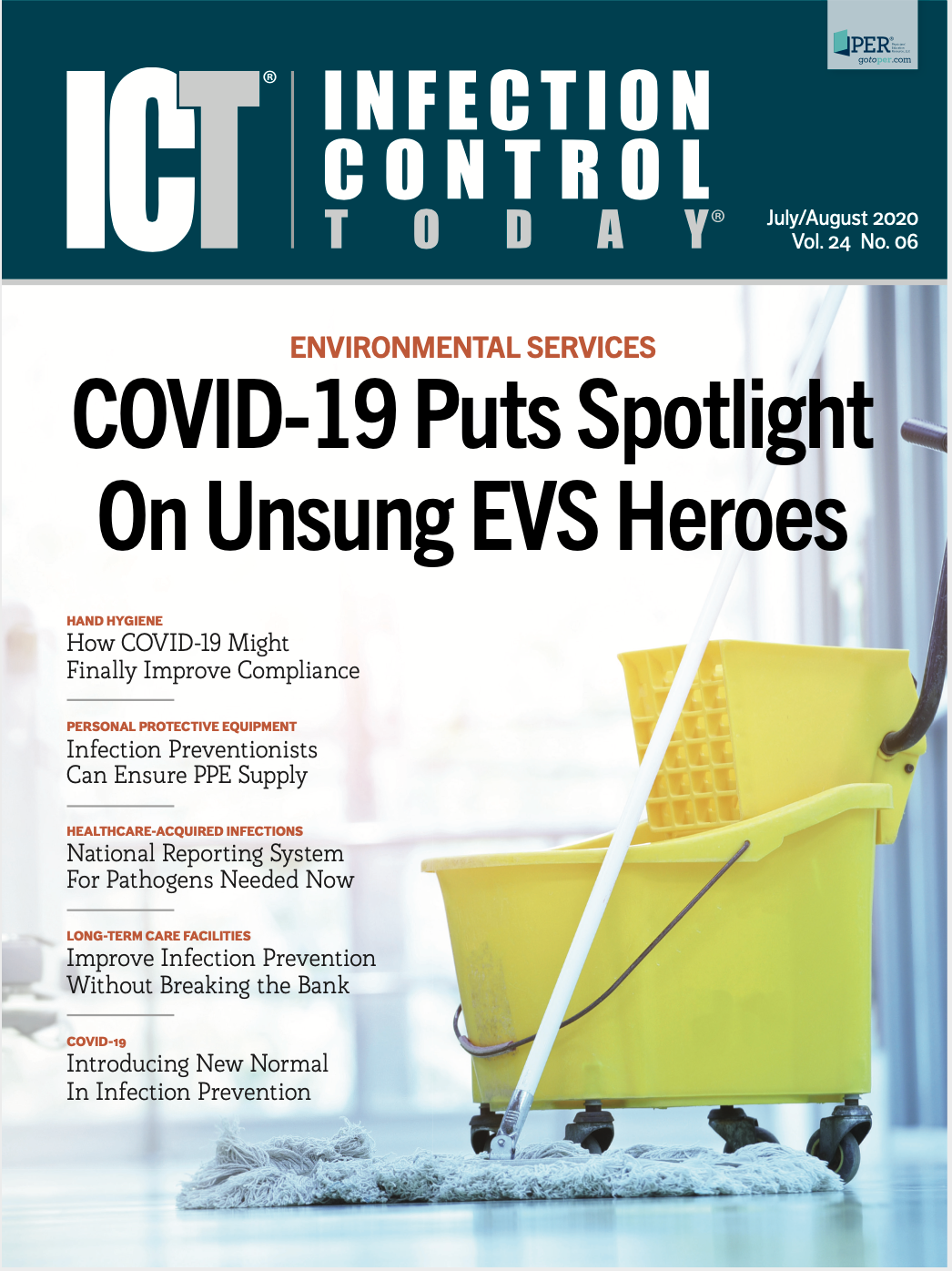Navigating the New Normal in Infection Prevention
It will also be necessary to again train other professionals the way IPs have historically trained them about infection prevention, because a lot of the old rules had to be set aside when COVID-19 surged.
You had questions, she had answers. Infection prevention consultant Sharon Ward-Fore, MS, MT (ASCP), CIC, held sway recently in a wide-ranging, hour-long Infection Control Today® webinar presentation that touched on a host of issues that infection preventionists (IPs) will need to be familiar with as society moves out of the shadow of coronavirus disease 2019 (COVID-19) and into the light of a new normal.
Sharon Ward-Fore, MS, MT (ASCP), CIC

“Infection prevention basically remains the same,” said Ward-Fore, who is also a member of Infection Control Today®’s Editorial Advisory Board. “The same tools will work: surveillance, rounding, auditing, tracking, tracing, teaching, coaching, being the calming voice when chaos reigns. Be watchful of what is happening locally and elsewhere, maintain this heightened sense of awareness through vigilance.”
Ward-Fore spoke to an audience of fellow IPs and other healthcare professionals during the webinar, hosted jointly by ICT® and Metrex. As society finds its bearings, IPs on will need to monitor workforce availability, facility considerations, testing capacity, personal protective equipment (PPE), infection prevention protocols, and regional considerations.
The first thing to keep in mind as COVID-19 case counts decline that it’s not really going away for good. “We know a second wave is coming,” Ward-Fore said. “We don’t know when or how bad it might be. So be prepared. Prepare by assessing your medical supplies, your equipment, and your PPE frequently, and don’t forget your staff. Make sure your staff is doing OK.”
It will also be necessary to again train other professionals the way IPs have historically trained them about infection prevention, because a lot of the old rules had to be set aside when COVID-19 surged. For instance, the PPE shortage led some hospitals to say that gowns need not be worn for patients with bacterial infections such as extended spectrum beta-lactamase-producing (ESBL) organisms, vancomycin-resistant Enterococcus (VRE), and methicillin-resistant Staphylococcus aureus (MRSA).
“This is a little different from our normal contact precautions for these kinds of organisms,” said Ward-Fore. “How do we justify the use of PPE when the pandemic is over for things like MRSA and VRE? When now we’re saying it’s OK to not use it?”
Ward-Fore suggested that IPs should be “tracking transmissions and strain typing, because right now the cat is out of the bag, so to speak, and how do we go back to our normal standard infection prevention protocols without a lot of pushback? The way we do that is starting to collect data now so that we have some information for what lies ahead. When everyone says, ‘We didn’t wear our PPE during the pandemic, why do we need to wear it now?’, IPs will have an answer.”
IPs will also need to monitor PPE donning and doffing. “IPs, it’s up to you to audit practices and give real-time feedback,” said Ward-Fore. “This is really important. I have walked through a hospital—I can’t tell you how many times—and seen people using PPE incorrectly.”
When Ward-Fore questions some professionals about how they’re using PPE, they’ll often tell her that they’d never been trained. “We have to train how to properly store and reuse PPE if it’s in short supply. We need to get out there and help our fellow healthcare workers learn how to do the right thing consistently, so they don’t make themselves sick.”
Ward-Fore brought her real-world experience to bear on guidelines by the US Centers for Disease Control and Prevention (CDC) and the World Health Organization (WHO). At one point she featured a WHO slide showing 11 steps for good hand hygiene.1
“This WHO diagram demonstrates how hand hygiene should be performed every time,” Ward-Fore said. “It’s almost like performing a surgical scrub. When it’s performed this way, meticulous and thoughtful, it can really make a difference in staff and patient safety. The challenge now, as it has been in the past, is how do we build in the time to perform like this for every patient encounter? If any of you figure that out, please let me know.”
That’s not to say she didn’t find WHO and CDC guidance useful. In fact, just the opposite. Ward-Fore praised guidelines created by both organizations and relied on them throughout her presentation.
For instance, when it comes to workforce availability, Ward-Fore said that IPs in the post-COVID world should always keep in mind the second wave. As soon as IPs spot a symptomatic worker, they should make sure that worker’s face is covered, inform the worker’s supervisor, and send the worker home.
“Now, the CDC has a lot of guidance around this in the Interim US Guidance for Risk Assessment and Work Restrictions for Healthcare Personnel with Potential Exposure to COVID-19,”2 said Ward-Fore. “It’s a mouthful, but it’s a really great resource that will help you figure out what to do with your staff and how to conduct a risk assessment to find out the different ways that you can manage your staff through a positive exposure or potential exposure.”
A good resource for staffing questions can be found on the CDC website under Strategies to Mitigate Healthcare Personnel Staffing Shortages,3 said Ward-Fore. “Lots of great tools and checklists to kind of help you maneuver through this quagmire of so many different questions with so many different answers.”
Try to maintain low patient volumes throughout the facility in the reopening phase. Place chairs 6 feet apart in waiting areas. “Now I’d like you all to close your eyes and visualize what some of your waiting rooms look like [currently],” Ward-Fore said. “I see a waiting room where patients are sitting shoulder to shoulder and back to back. Even in the best of times, this really is not a good setup. Think about the cold and flu season. People are right next to each other spreading and shedding. We need to think about ways to reduce crowding in waiting rooms.”
The post-COVID-19 healthcare facility should be full of visual reminders for patients, staff, and visitors, said Ward-Fore. “You should consider printing and placing signage throughout your facility to remind patients about the social distancing standards, respiratory hygiene, and cough etiquette, and hand hygiene,” Ward-Fore said. “They say you should place visual alerts such as signs and posters actually all over the place. So that nothing is missed, and these would be things on hand hygiene, respiratory hygiene, and cough etiquette.”
Patient screening will become a more important aspect of care. “Infection preventionists have known the importance of patient screening for quite a long time,” Ward-Fore said. “As an IP that covered the ED, basic everyday patient screening and triage was very, very important.”
When diseases like pertussis or measles were circulating, IPs would ask the patient if he or she had traveled recently and, if so, where. Screening questions were developed to help identify Candida auris when that popped up a few years ago.”
Treatment protocols should be based on what’s relevant to a particular healthcare institution: hospital, primary care practice, urgent care center, or mini-clinic. “When I was an IP, I worked in the emergency department and I developed this thing I called the respiratory hygiene algorithm for the ED staff,” Ward-Fore said. “And it was simply a list of communicable diseases like mumps, measles, pertussis.”
She needed to determine: What actions needed to be taken? Did patients need to go into negative airflow rooms? Were droplet precautions needed?
“And it was just the way to simplify how patients move through triage,” said Ward-Fore. “It provided a quick guidance on symptoms, presentation, masking, a need for additional precautions. So, think about how you might be able to develop your protocol and make it simple.”
IPs will also, as always, have to monitor the environmental services (EVS) staff. “Practices drift,” Ward-Fore said. “Staff may be in a hurry. And sometimes staff think more is better. And I actually saw this at my former institution where the staff thought if you use 3 squirts, then 10 squirts is better. So be sure that you’re monitoring this regularly, and train, train, train and audit to make sure everyone’s following the same protocol.”
Clean from top to bottom, clean to dirty, clockwise or counterclockwise. “Clean before disinfection,” Ward-Fore said. “I can’t tell you enough how important this is. If there is bioburden on a particular item, a medical device or a patient tray in their room, unless you remove that bioburden the disinfectant is not able to touch those surfaces. It’s really important to clean before disinfection.”
IPs should know who is responsible for cleaning what. But more than that, everybody should know who’s responsible for cleaning what.
“This is a process that seems to break down fairly regularly,” said Ward-Fore. “When I covered surgical services, this happened fairly often. People would point the finger at each other and say, ‘Oh, well anesthesia cleans this but EVS cleans that.’”
IPs also need to specify how often something should be cleaned. Waiting rooms and other areas where patients tend to congregate for a long time should be cleaned more frequently.
Make sure there’s a plan to thoroughly clean and disinfect all patient care items. Exam rooms are different than public waiting rooms and not all waiting rooms or exam rooms are the same.
“What you really need to do also is try and limit the amount of supplies and equipment in the room to make it easier to clean,” said Ward-Fore. “Keep your supplies stored in cabinets or drawers. That’s actually why they’re there. And be sure you can close them. There’s no need for seven days’ worth of linen or enough IV bags on the counter for an entire week’s worth of surgeries. IPs, does this sound familiar? Probably.”
Finally, IPs should be aware of who among their fellow healthcare workers seems stressed out. “Recognize the toll this prolonged heightened awareness may take on staff physically and emotionally,” said Ward-Fore. “The staff worldwide have been troupers but how long can they maintain that? So be cognizant of that. Let each other know that you have each other's backs and that you’re there for each other.”
References:
1: World Health Organization. Wash hands when visibly soiled. WHO website. https://www.who.int/gpsc/5may/How_To_HandWash_Poster.pdf?ua=1
2: Centers for Disease Control and Prevention. Interim U.S. Guidance for Risk Assessment and Work Restrictions for Healthcare Personnel with Potential Exposure to COVID-19. CDC website. https://www.cdc.gov/coronavirus/2019-ncov/hcp/guidance-risk-assesment-hcp.html
3: Centers for Disease Control and Prevention. Strategies to Mitigate Healthcare Personnel Staffing Shortages. CDC website. https://www.cdc.gov/coronavirus/2019-ncov/hcp/mitigating-staff-shortages.html

“Ongoing Assault”: How HHS Layoffs Have Eviscerated Infection Prevention Support Across the Nation
April 1st 2025Mass layoffs at HHS and CDC have gutted critical infection prevention programs, leaving frontline professionals overwhelmed, under-resourced, and desperate to safeguard public health.
“Ongoing Assault”: How HHS Layoffs Have Eviscerated Infection Prevention Support Across the Nation
April 1st 2025Mass layoffs at HHS and CDC have gutted critical infection prevention programs, leaving frontline professionals overwhelmed, under-resourced, and desperate to safeguard public health.
2 Commerce Drive
Cranbury, NJ 08512